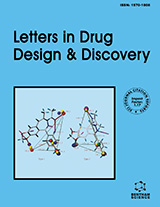Abstract
In this study, the role of highly structured water molecules present in the active site of the leukotriene A4 hydrolase (LTA4H) enzyme has been critically examined through the docking experiments. It was observed that different experiments were necessary to perform the docking studies. The ligands capable of displacing or interacting with bound-water(s) displayed different binding poses as well as the scores. The docking scores E (CvdW) from Glide and ChemScore (CS) from FlexX, with and without bound-waters, obtained through different docking experiments were used to construct two structure guided bi-parametric linear regression models using the IC50 enzyme activity data. The predictive squared correlation coefficients (Q2) obtained for these models, with and without bound waters, were found to be 0.73 and 0.67, respectively. These models were validated using test and validated sets of compounds. Utilizing these QSAR models, 409 proposed structures were docked and their respective predicted IC50 data were generated. From the in-silico evaluation of these 409 proposed structures representing diverse chemotypes, 39 compounds were triaged, synthesized and evaluated in the enzyme inhibition assay. The predicted and experimental biological data (IC50) was correlated and the square of the correlation coefficient (R2) between the observed and calculated IC50 was found to be 0.87.
Keywords: Crystallographic waters, structure based QSAR, docking, scoring function.
Current Computer-Aided Drug Design
Title:A Structure Guided QSAR: A Rapid and Accurate technique to predict IC50: A Case Study
Volume: 11 Issue: 2
Author(s): Rama K. Mishra and Jasbir Singh
Affiliation:
Keywords: Crystallographic waters, structure based QSAR, docking, scoring function.
Abstract: In this study, the role of highly structured water molecules present in the active site of the leukotriene A4 hydrolase (LTA4H) enzyme has been critically examined through the docking experiments. It was observed that different experiments were necessary to perform the docking studies. The ligands capable of displacing or interacting with bound-water(s) displayed different binding poses as well as the scores. The docking scores E (CvdW) from Glide and ChemScore (CS) from FlexX, with and without bound-waters, obtained through different docking experiments were used to construct two structure guided bi-parametric linear regression models using the IC50 enzyme activity data. The predictive squared correlation coefficients (Q2) obtained for these models, with and without bound waters, were found to be 0.73 and 0.67, respectively. These models were validated using test and validated sets of compounds. Utilizing these QSAR models, 409 proposed structures were docked and their respective predicted IC50 data were generated. From the in-silico evaluation of these 409 proposed structures representing diverse chemotypes, 39 compounds were triaged, synthesized and evaluated in the enzyme inhibition assay. The predicted and experimental biological data (IC50) was correlated and the square of the correlation coefficient (R2) between the observed and calculated IC50 was found to be 0.87.
Export Options
About this article
Cite this article as:
K. Mishra Rama and Singh Jasbir, A Structure Guided QSAR: A Rapid and Accurate technique to predict IC50: A Case Study, Current Computer-Aided Drug Design 2015; 11 (2) . https://dx.doi.org/10.2174/1573409911666150702100839
| DOI https://dx.doi.org/10.2174/1573409911666150702100839 |
Print ISSN 1573-4099 |
| Publisher Name Bentham Science Publisher |
Online ISSN 1875-6697 |
 36
36 3
3 1
1
- Author Guidelines
- Bentham Author Support Services (BASS)
- Graphical Abstracts
- Fabricating and Stating False Information
- Research Misconduct
- Post Publication Discussions and Corrections
- Publishing Ethics and Rectitude
- Increase Visibility of Your Article
- Archiving Policies
- Peer Review Workflow
- Order Your Article Before Print
- Promote Your Article
- Manuscript Transfer Facility
- Editorial Policies
- Allegations from Whistleblowers
Related Articles
-
Allergy to Miscellaneous Household Arthropods
Protein & Peptide Letters Hsp90 Affecting Chromatin Remodeling Might Explain Transgenerational Epigenetic Inheritance in Drosophila
Current Genomics VEGF Signaling in Cancer Treatment
Current Pharmaceutical Design Cationic Transfection Lipids in Gene Therapy: Successes, Set-backs, Challenges and Promises
Current Medicinal Chemistry Somatic Mutations, Viral Integration and Epigenetic Modification in the Evolution of Hepatitis B Virus-Induced Hepatocellular Carcinoma
Current Genomics TNF-α and IL-6: The Link between Immune and Bone System
Current Drug Targets Utility of Ethylidenethiosemicarbazides in Heterocyclic Synthesis
Current Organic Synthesis Application of High Hydrostatic Pressure to Dissociate Aggregates and Refold Proteins
Current Pharmaceutical Biotechnology Naturally Occurring Methyl Salicylate Glycosides
Mini-Reviews in Medicinal Chemistry Osteogenic Differentiation Factors of Multipotent Mesenchymal Stromal Cells in the Current Understanding
Current Pharmaceutical Design Canine Nutritional Model: Influence of Age, Diet, and Genetics on Health and Well-Being
Current Nutrition & Food Science Stem-cell-based Therapies for Improving Islet Transplantation Outcomes in Type 1 Diabetes
Current Diabetes Reviews Endogenous Cardioprotective Agents: Role in Pre and Postconditioning
Current Drug Targets Effect of Dipeptidyl Peptidase-4 Inhibitors on Plasma Adiponectin: A Systematic Review and Meta-Analysis of Randomized Controlled Trials
Current Medicinal Chemistry Promotion of Remyelination by Immunoglobulins: Implications for the Treatment of Multiple Sclerosis
Current Pharmaceutical Design Probing into Therapeutic Anti-cancer Potential of Apigenin: Recent Trends and Future Directions
Recent Patents on Inflammation & Allergy Drug Discovery Immunosuppressive Therapies in Solid Organ Transplantation
Immunology, Endocrine & Metabolic Agents in Medicinal Chemistry (Discontinued) Nicotinic Acid and its Derivatives: Synthetic Routes, Crystal Forms and Polymorphs
Current Drug Discovery Technologies Cell Death: Tipping the Balance of Autoimmunity and Tissue Repair
Current Pharmaceutical Design Overcoming the Challenges of siRNA Delivery: Nanoparticle Strategies
Current Drug Delivery


























